5 tips to Create Effective and Inspiring Fashion Mood Boards (Your Ultimate Guide)
Jun 17, 2024

Asal Azimi
As a fashion designer, you have one clear goal: to convert your ideas into reality.
Mastering a well-crafted fashion mood board is essential to the creative journey. It allows you to capture the essence of your ideas while ensuring your entire team is on the same page. Furthermore, it serves as a source of inspiration and visual aid to help with the creative process and the development of a business strategy.
However, creating a fashion mood board takes much more than just throwing together a few appealing pictures.
In this guide, we'll show you 5 effective strategies for communicating your vision. From gathering inspiration and establishing your concept to organizing and finetuning your board, we’ll help you get started.
Are you ready to take your fashion projects to the next level?
Let's dive in.
What exactly is a fashion mood board?
A fashion mood board is a visual diary of elements and inspirations that serves as a guideline and ongoing source of inspiration as the new collection is finalized.
It mainly consists of images, colors, textures, and other visual components that designers and stylists use to communicate their creative vision for a certain project or collection.
Fashion mood boards are essential tools for designers, as they help to convey the overall look and feel of a collection before any actual garments are created.
By gathering inspiration from various sources, such as images, fabric swatches, and color palettes, designers can create a visual depiction of their ideas that can be easily shared with team members and stakeholders.
What are the different types of fashion mood boards?
There are essentially two types of fashion mood boards:
Physical mood boards: These are traditional collages made by hand, using printed images, fabric swatches, and other tactile materials. Physical mood boards offer a hands-on approach to the creative process and can be particularly useful for designers who prefer to work with more tangible elements.
Digital mood boards: With the rise of modern technology, many designers now opt for digital mood boards by using software like Adobe Photoshop, InDesign, or online tools such as Pinterest or Milanote. Digital mood boards provide the benefit of easy sharing and collaboration, as well as the flexibility to quickly make adjustments or additions, if necessary.
What is the purpose of a fashion mood board?
The primary goal of a mood board is to focus the designer's attention on the aesthetic, style, and direction of the collection, while also communicating the color influences and design area. By establishing a clear visual representation of the desired aesthetic, mood boards minimize misunderstandings during the initial stages - which ultimately reduces problems down the road.
In a nutshell: Mood boards are visual reference points throughout the design process, ensuring that everyone involved is working toward the same goal.
Benefits of using fashion mood boards
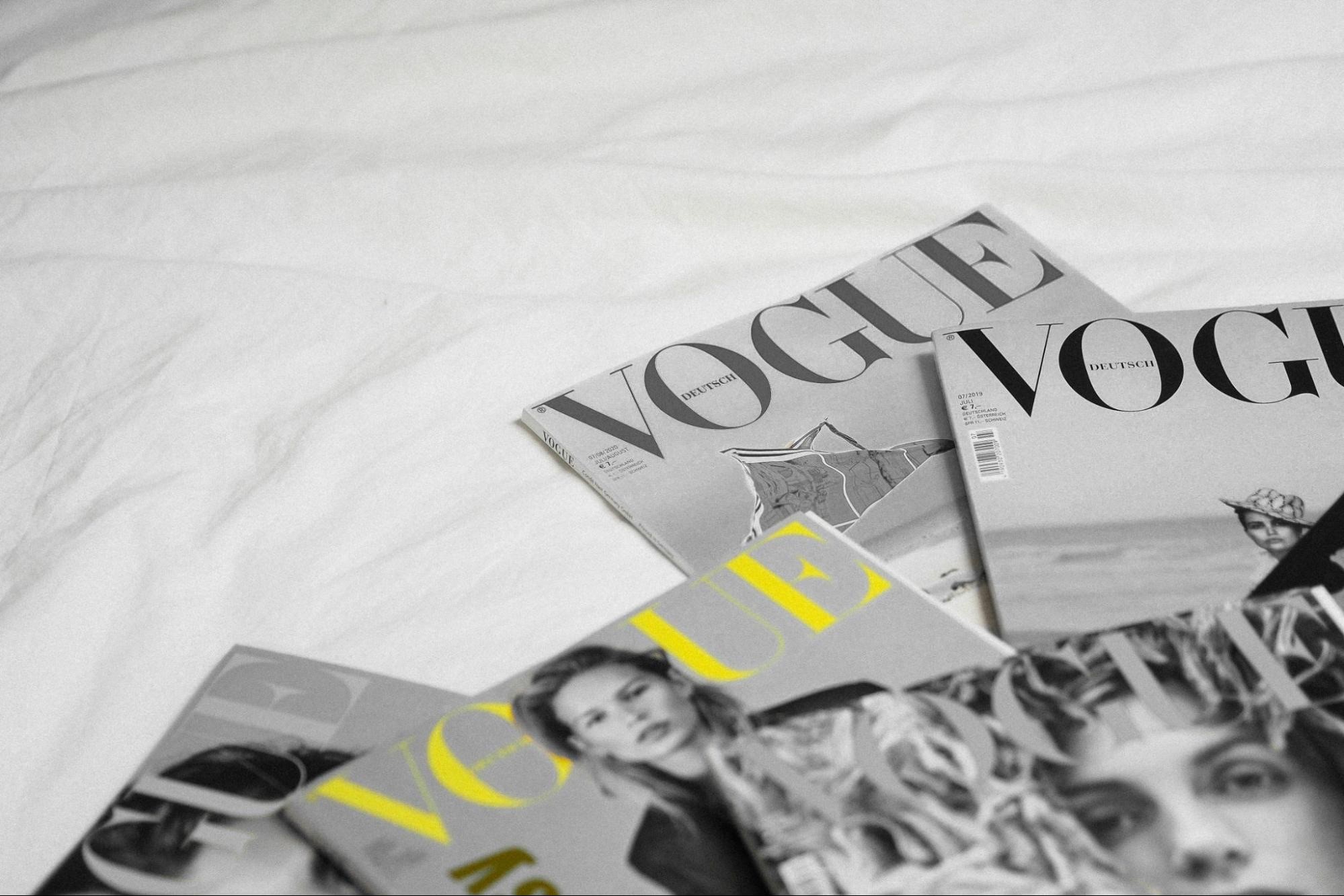
Using fashion mood boards offers several key benefits for both designers and their teams:
Time and resource-saving: Instead of jumping right into the action, mood boards create a consistent vision, providing a foundation for the actions your project needs and how you should schedule them. It’s pretty simple: By outlining a project step by step, you avoid time-consuming revisions later on. This technique allows designers to focus on creating the best possible product.
More inspiration: It is quite common to experience roadblocks during the creative process. By creating a mood board you can jump-start your project and trigger a creative and calm “flow state”. In this way, you can tap into your creativity more easily and come up with your best ideas.
Clear communication: Mood boards provide a common foundation for designers, stylists, and other team members to discuss and refine their ideas. By visualizing the desired aesthetic, mood boards help to minimize misunderstandings and ensure that everyone is on the same page.
Consistency in design direction: Mood boards serve as a reference point throughout the design process, helping to maintain consistency in the overall look and feel of the collection and simplify the process. This is particularly important when working with large teams or on complex projects.
Stronger client relationships: A mood board is an easy-to-use instrument for transparent communication with your clients that you can modify as the brainstorming process progresses until everyone is satisfied. Clients are more likely to trust you when they feel engaged. This eases the process for you in the future when a tough choice needs to be made.
How to create the ultimate fashion mood board
Step 1: Gather inspiration and define your concept
First things first: Before you start creating your fashion mood board, it's essential to have a clear idea of the concept and message you want to convey. Start by researching current trends, color palettes, and styles that reflect your vision. You can look for inspiration in fashion magazines, online platforms, and social media accounts of influential designers and innovative brands.
As you gather inspiration, identify the key elements and themes you want to incorporate into your mood board. These could include specific color schemes, textures, patterns, or silhouettes that resonate with your fashion concept. By making a list of these elements, you can easily guide your image selection process in the next step.
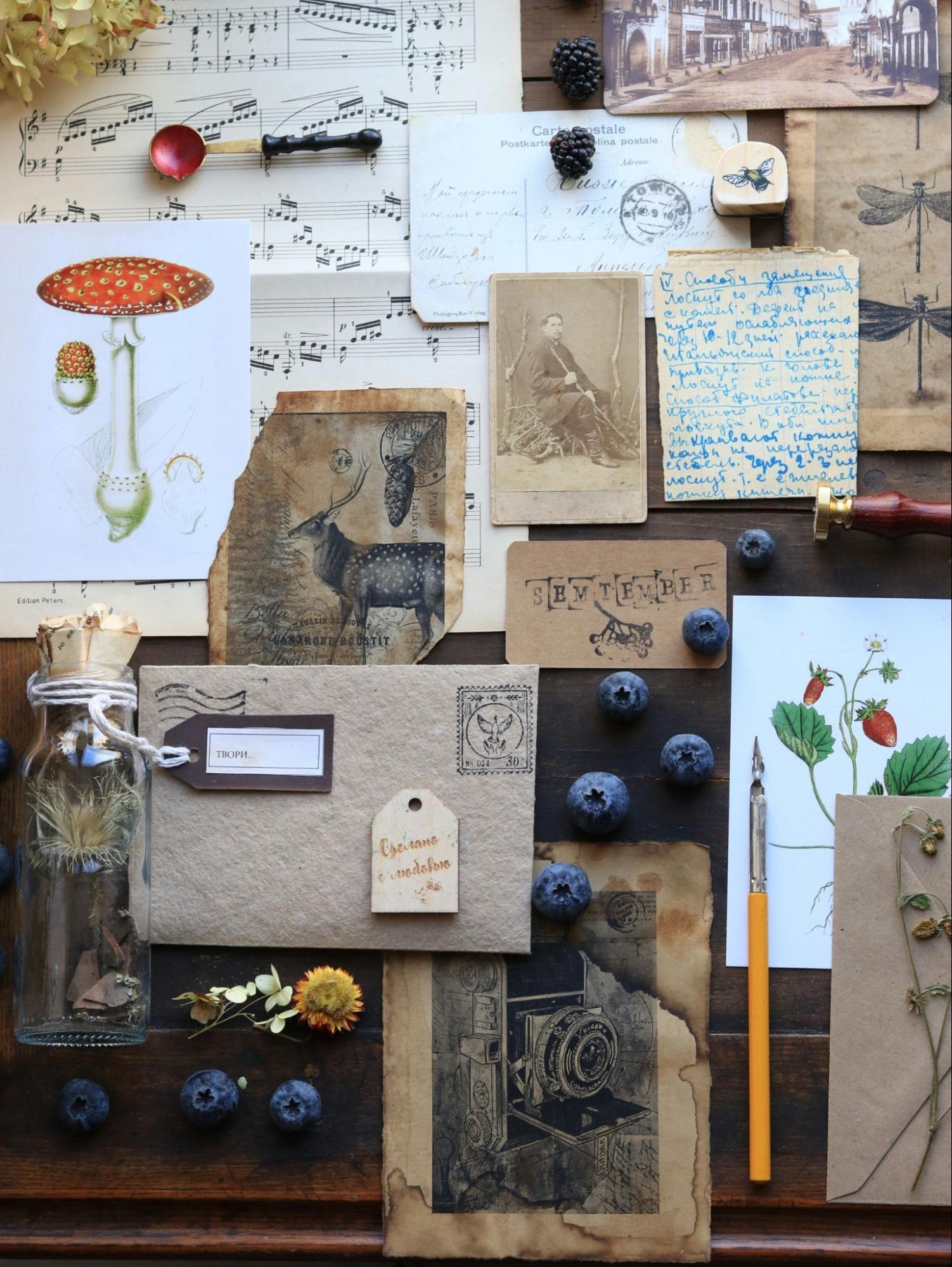
Tips for defining your concept
Write down words that describe the mood and aesthetic of your ideas
Consider your target audience and the message you want to convey through your fashion designs
Create a mind map or brainstorming sheet to collect and organize your ideas and inspiration
Step 2: Select inspiring images and material
With a specific concept in mind, start gathering high-quality images that represent your vision. Look for photographs, illustrations, and graphics from multiple sources, such as fashion magazines, websites, or your own personal collection. Focus on a diverse range of images that showcase different aspects of your concept, such as garment details, accessories, and overall styling.
Besides digital images, consider including physical materials that add depth and texture to your mood board. Fabric swatches, color samples, and other tactile elements can provide a more immersive experience and make your mood board more tangible for viewers.
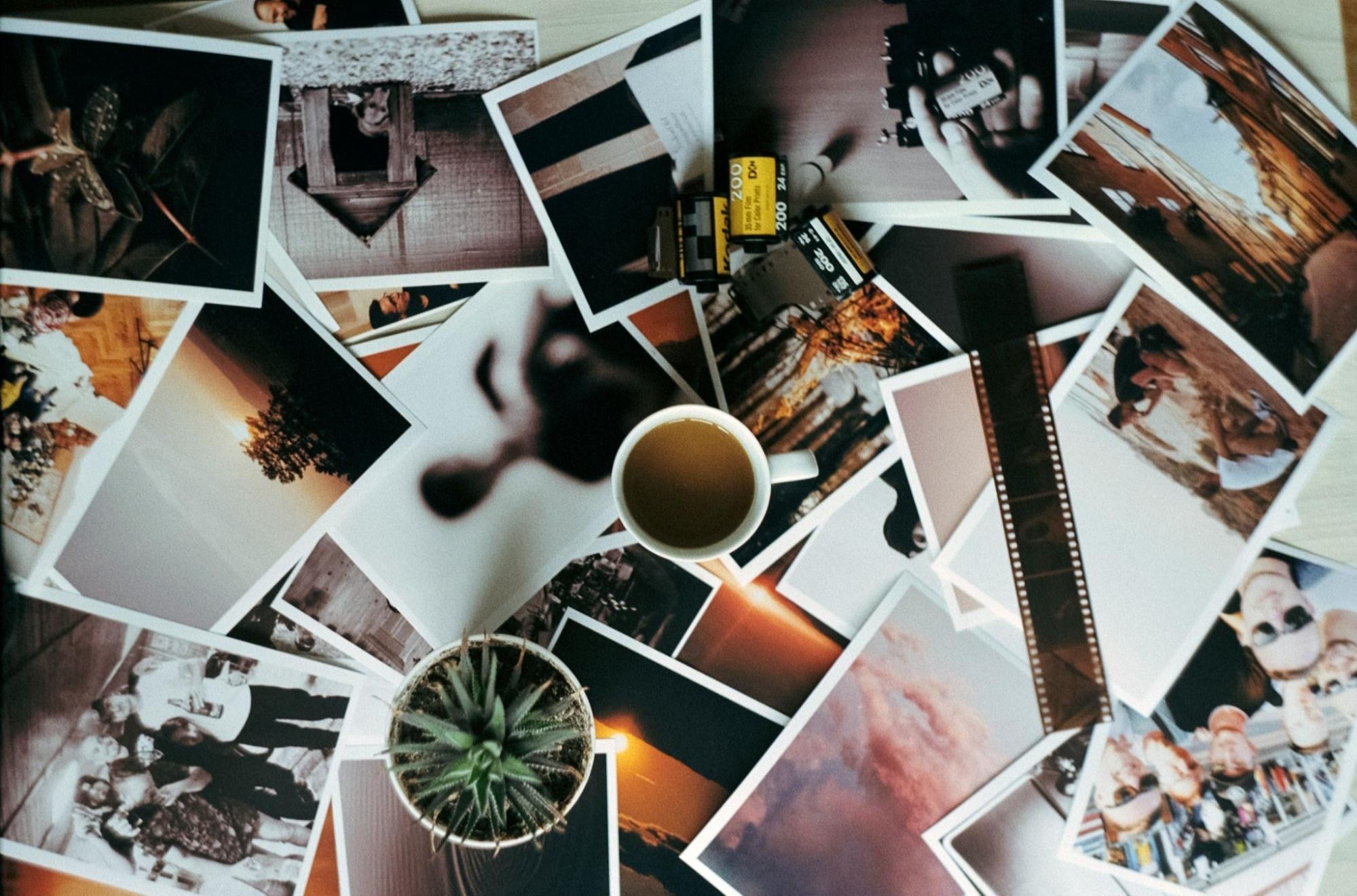
Where to find high-quality images
Fashion and lifestyle magazines (e.g., Vogue, Elle, Harper's Bazaar)
Online stock photography websites (e.g., Unsplash, Shutterstock, Getty Images)
Social media platforms (e.g., Instagram, Pinterest)
Fashion brand websites and lookbooks
Milanote's integrated image search for dynamic and interactive mood boards
Reddit's r/femalefashionadvice community for resources and inspiration
YouTube tutorials and fashion designer channels for visual guidance
Canva's online mood board maker for easy design and creation
Step 3: Arrange and compose your mood board
With your handpicked selection of images and materials, it's now time to start arranging them on your mood board. Experiment with different layouts and compositions to create a visually appealing and cohesive design.
Remember: Always keep the balance between images, text, and negative space in mind to ensure that your mood board is easy to read and understand.
Another helpful approach is to use a grid or template to maintain structure and alignment. This can be as simple as dividing your board into equal sections or using a more complex layout that includes overlapping elements.
As you arrange your images, pay attention to the flow and hierarchy of information, placing the most important or impactful elements in prominent positions. This technique guarantees a more appealing visual presentation.
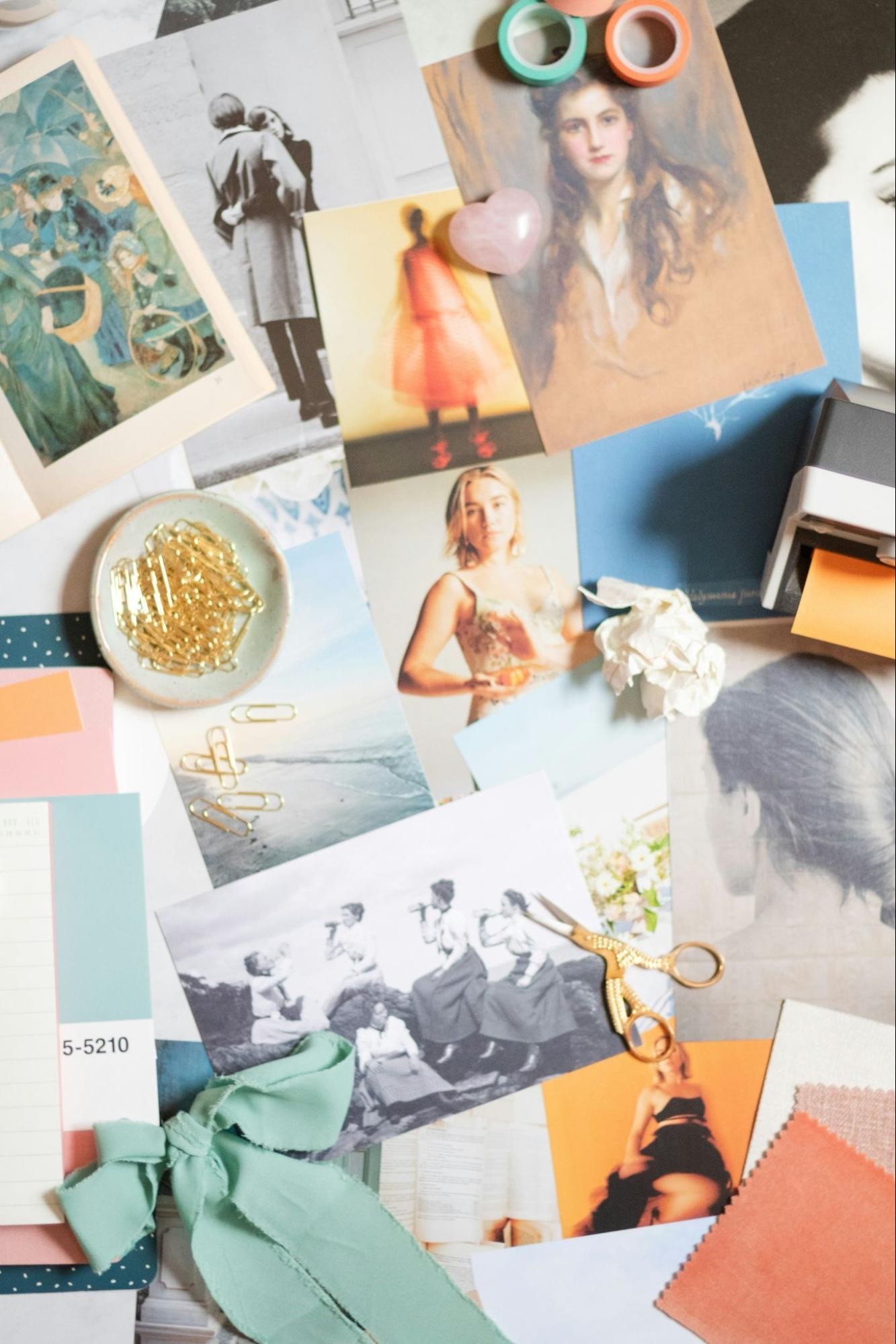
Composition techniques
Use the rule of thirds to create a balanced and dynamic layout
Vary the size and scale of images to create visual interest and emphasis
Arrange images by color, theme, or style to create a cohesive narrative
Leave some negative space to avoid overwhelming the viewer
Step 4: Add text and comments to provide context
Even though images should take the spotlight of your mood board, including text and comments can help provide context and clarify the significance of each element. Add keywords, phrases, or quotes that capture the essence of your ideas and create the desired mood or emotion.
In addition to creative text elements, consider adding brief explanations or notes next to specific images or materials. These comments can draw attention to important details, provide background information, or explain how a particular element relates to your overall fashion vision.
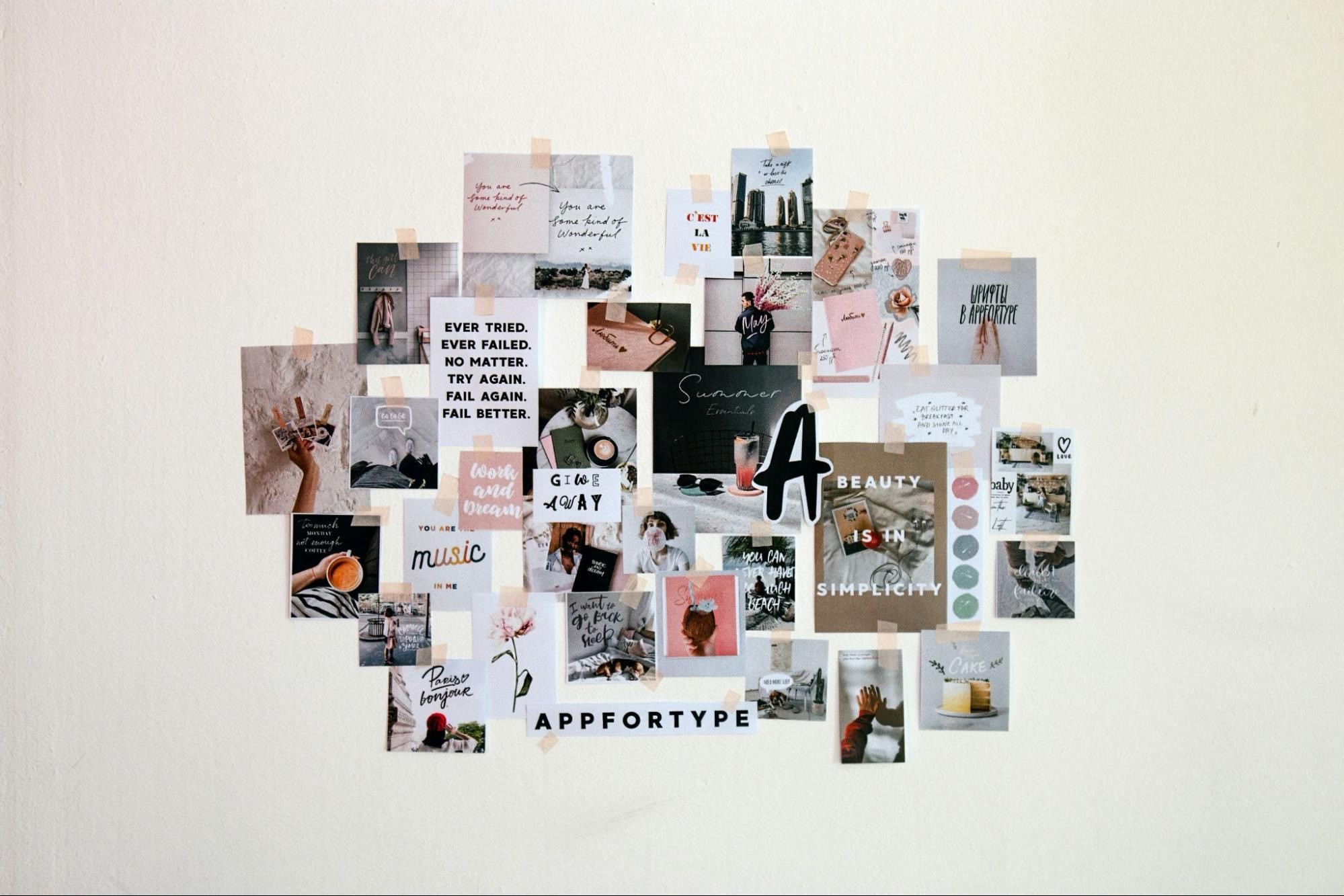
Ideas for text and comments
Use a consistent font and color scheme for text elements
Use handwritten notes or sketches to add a personal touch
Use labels or arrows to highlight specific details or connections
Include inspirational quotes or phrases that resonate with your design concept
Step 5: Refine and present your fashion mood board
Once you have arranged all the elements on your mood board, take a step back and review your work with a critical eye. Evaluate whether the overall composition effectively communicates your fashion vision and evokes the desired mood or atmosphere. If necessary, you can make adjustments, such as replacing images, changing the layout, or refining the text elements.
When your mood board is complete, consider the most effective approach to show it to your customer or team. If you are using a physical board, be sure it is well-made, robust, and has all of the components properly attached. For digital mood boards, choose a file format that preserves the image quality and is easy to share and view on various devices.
—
By following these five steps, you will be able to create a fashion mood board that stands out and makes your unique fashion ideas come to life – an effective way to impress both your clients and your team!
As a fashion designer, you have one clear goal: to convert your ideas into reality.
Mastering a well-crafted fashion mood board is essential to the creative journey. It allows you to capture the essence of your ideas while ensuring your entire team is on the same page. Furthermore, it serves as a source of inspiration and visual aid to help with the creative process and the development of a business strategy.
However, creating a fashion mood board takes much more than just throwing together a few appealing pictures.
In this guide, we'll show you 5 effective strategies for communicating your vision. From gathering inspiration and establishing your concept to organizing and finetuning your board, we’ll help you get started.
Are you ready to take your fashion projects to the next level?
Let's dive in.
What exactly is a fashion mood board?
A fashion mood board is a visual diary of elements and inspirations that serves as a guideline and ongoing source of inspiration as the new collection is finalized.
It mainly consists of images, colors, textures, and other visual components that designers and stylists use to communicate their creative vision for a certain project or collection.
Fashion mood boards are essential tools for designers, as they help to convey the overall look and feel of a collection before any actual garments are created.
By gathering inspiration from various sources, such as images, fabric swatches, and color palettes, designers can create a visual depiction of their ideas that can be easily shared with team members and stakeholders.
What are the different types of fashion mood boards?
There are essentially two types of fashion mood boards:
Physical mood boards: These are traditional collages made by hand, using printed images, fabric swatches, and other tactile materials. Physical mood boards offer a hands-on approach to the creative process and can be particularly useful for designers who prefer to work with more tangible elements.
Digital mood boards: With the rise of modern technology, many designers now opt for digital mood boards by using software like Adobe Photoshop, InDesign, or online tools such as Pinterest or Milanote. Digital mood boards provide the benefit of easy sharing and collaboration, as well as the flexibility to quickly make adjustments or additions, if necessary.
What is the purpose of a fashion mood board?
The primary goal of a mood board is to focus the designer's attention on the aesthetic, style, and direction of the collection, while also communicating the color influences and design area. By establishing a clear visual representation of the desired aesthetic, mood boards minimize misunderstandings during the initial stages - which ultimately reduces problems down the road.
In a nutshell: Mood boards are visual reference points throughout the design process, ensuring that everyone involved is working toward the same goal.
Benefits of using fashion mood boards

Using fashion mood boards offers several key benefits for both designers and their teams:
Time and resource-saving: Instead of jumping right into the action, mood boards create a consistent vision, providing a foundation for the actions your project needs and how you should schedule them. It’s pretty simple: By outlining a project step by step, you avoid time-consuming revisions later on. This technique allows designers to focus on creating the best possible product.
More inspiration: It is quite common to experience roadblocks during the creative process. By creating a mood board you can jump-start your project and trigger a creative and calm “flow state”. In this way, you can tap into your creativity more easily and come up with your best ideas.
Clear communication: Mood boards provide a common foundation for designers, stylists, and other team members to discuss and refine their ideas. By visualizing the desired aesthetic, mood boards help to minimize misunderstandings and ensure that everyone is on the same page.
Consistency in design direction: Mood boards serve as a reference point throughout the design process, helping to maintain consistency in the overall look and feel of the collection and simplify the process. This is particularly important when working with large teams or on complex projects.
Stronger client relationships: A mood board is an easy-to-use instrument for transparent communication with your clients that you can modify as the brainstorming process progresses until everyone is satisfied. Clients are more likely to trust you when they feel engaged. This eases the process for you in the future when a tough choice needs to be made.
How to create the ultimate fashion mood board
Step 1: Gather inspiration and define your concept
First things first: Before you start creating your fashion mood board, it's essential to have a clear idea of the concept and message you want to convey. Start by researching current trends, color palettes, and styles that reflect your vision. You can look for inspiration in fashion magazines, online platforms, and social media accounts of influential designers and innovative brands.
As you gather inspiration, identify the key elements and themes you want to incorporate into your mood board. These could include specific color schemes, textures, patterns, or silhouettes that resonate with your fashion concept. By making a list of these elements, you can easily guide your image selection process in the next step.

Tips for defining your concept
Write down words that describe the mood and aesthetic of your ideas
Consider your target audience and the message you want to convey through your fashion designs
Create a mind map or brainstorming sheet to collect and organize your ideas and inspiration
Step 2: Select inspiring images and material
With a specific concept in mind, start gathering high-quality images that represent your vision. Look for photographs, illustrations, and graphics from multiple sources, such as fashion magazines, websites, or your own personal collection. Focus on a diverse range of images that showcase different aspects of your concept, such as garment details, accessories, and overall styling.
Besides digital images, consider including physical materials that add depth and texture to your mood board. Fabric swatches, color samples, and other tactile elements can provide a more immersive experience and make your mood board more tangible for viewers.

Where to find high-quality images
Fashion and lifestyle magazines (e.g., Vogue, Elle, Harper's Bazaar)
Online stock photography websites (e.g., Unsplash, Shutterstock, Getty Images)
Social media platforms (e.g., Instagram, Pinterest)
Fashion brand websites and lookbooks
Milanote's integrated image search for dynamic and interactive mood boards
Reddit's r/femalefashionadvice community for resources and inspiration
YouTube tutorials and fashion designer channels for visual guidance
Canva's online mood board maker for easy design and creation
Step 3: Arrange and compose your mood board
With your handpicked selection of images and materials, it's now time to start arranging them on your mood board. Experiment with different layouts and compositions to create a visually appealing and cohesive design.
Remember: Always keep the balance between images, text, and negative space in mind to ensure that your mood board is easy to read and understand.
Another helpful approach is to use a grid or template to maintain structure and alignment. This can be as simple as dividing your board into equal sections or using a more complex layout that includes overlapping elements.
As you arrange your images, pay attention to the flow and hierarchy of information, placing the most important or impactful elements in prominent positions. This technique guarantees a more appealing visual presentation.

Composition techniques
Use the rule of thirds to create a balanced and dynamic layout
Vary the size and scale of images to create visual interest and emphasis
Arrange images by color, theme, or style to create a cohesive narrative
Leave some negative space to avoid overwhelming the viewer
Step 4: Add text and comments to provide context
Even though images should take the spotlight of your mood board, including text and comments can help provide context and clarify the significance of each element. Add keywords, phrases, or quotes that capture the essence of your ideas and create the desired mood or emotion.
In addition to creative text elements, consider adding brief explanations or notes next to specific images or materials. These comments can draw attention to important details, provide background information, or explain how a particular element relates to your overall fashion vision.

Ideas for text and comments
Use a consistent font and color scheme for text elements
Use handwritten notes or sketches to add a personal touch
Use labels or arrows to highlight specific details or connections
Include inspirational quotes or phrases that resonate with your design concept
Step 5: Refine and present your fashion mood board
Once you have arranged all the elements on your mood board, take a step back and review your work with a critical eye. Evaluate whether the overall composition effectively communicates your fashion vision and evokes the desired mood or atmosphere. If necessary, you can make adjustments, such as replacing images, changing the layout, or refining the text elements.
When your mood board is complete, consider the most effective approach to show it to your customer or team. If you are using a physical board, be sure it is well-made, robust, and has all of the components properly attached. For digital mood boards, choose a file format that preserves the image quality and is easy to share and view on various devices.
—
By following these five steps, you will be able to create a fashion mood board that stands out and makes your unique fashion ideas come to life – an effective way to impress both your clients and your team!
